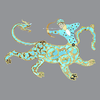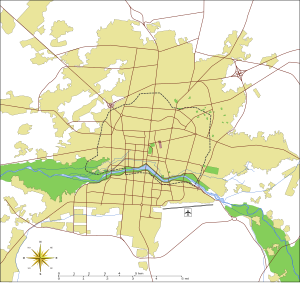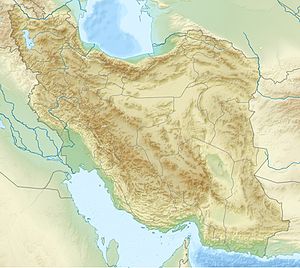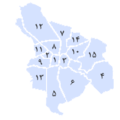Isfahan
This article has multiple issues. Please help or discuss these issues on the talk page. (Learn how and when to remove these template messages)
|
Isfahan
اصفهان Spahān, Aspadana | |
|---|---|
City | |
       Top-bottom, R-L:Naqsh-e Jahan Square View from Keisaria gate Si-o-se-pol • Khaju Bridge Flower Garden of Isfahan • Chehel Sotoun Shah Mosque • Vank Cathedral | |
 Seal  Coat of arms | |
| Nickname(s): Nesf-e Jahān (Half of the World) | |
 Isfahan | |
 | |
 Isfahan Isfahan in Iran | |
| Coordinates: 32°38′41″N 51°40′03″E / 32.64472°N 51.66750°ECoordinates: 32°38′41″N 51°40′03″E / 32.64472°N 51.66750°E | |
| Country | |
| Province | Isfahan |
| County | Isfahan |
| District | Central |
| Government | |
| • Mayor | Ali Ghasemzadeh |
| • City Council | Mohammad Nour Salehi (Chairman) |
| Area | |
| • Urban | 551 km2 (213 sq mi) |
| Elevation | 1,574 m (5,217 ft) |
| Population (2016 Census) | |
| • Urban | 1,961,260[2] |
| • Metro | 3,989,070[3] |
| • Population Rank in Iran | 3rd |
| Time zone | UTC+3:30 (IRST) |
| • Summer (DST) | UTC+4:30 (IRDT 21 March – 20 September) |
| Area code(s) | 031 |
| Climate | BWk[4] |
| Website | isfahan.ir |
| Isfahan city |
|---|
 |
Isfahan (Persian: اصفهان, romanized: Esfahān [esfæˈhɒːn] (![]() listen)), from its ancient designation Aspadana and later Spahan in middle Persian, rendered in English as Ispahan, is a major city in Greater Isfahan Region, Isfahan Province, Iran. It is located 406 kilometres (252 miles) south of Tehran and it is the capital of Isfahan Province. Isfahan has a population of approximately 1.9 million,[5] making it the third-largest city in Iran, after Mashhad and Tehran, and the second-largest metropolitan area.[6]
listen)), from its ancient designation Aspadana and later Spahan in middle Persian, rendered in English as Ispahan, is a major city in Greater Isfahan Region, Isfahan Province, Iran. It is located 406 kilometres (252 miles) south of Tehran and it is the capital of Isfahan Province. Isfahan has a population of approximately 1.9 million,[5] making it the third-largest city in Iran, after Mashhad and Tehran, and the second-largest metropolitan area.[6]
It is located at the intersection of the two principal north–south and east–west routes that traverse Iran. Isfahan flourished between the 9th and 18th centuries under the Safavid dynasty, when it became the capital of Persia for the second time in its history under Shah Abbas the Great. The city retains much of its history. It is famous for its Perso–Islamic architecture, grand boulevards, covered bridges, palaces, tiled mosques, and minarets. Isfahan also has many historical buildings, monuments, paintings, and artifacts. The fame of Isfahan led to the Persian proverb "Esfahān nesf-e-jahān ast": Isfahan is half (of) the world.[7] The Naqsh-e Jahan Square in Isfahan is one of the largest city squares in the world. UNESCO has designated it a World Heritage Site.[8]
Etymology[]
Isfahan is derived from Middle Persian Spahān. Spahān is attested in various Middle Persian seals and inscriptions, including that of the Zoroastrian magi Kartir,[9] and is also the Armenian name of the city (Սպահան). The present-day name is the Arabicized form of Ispahan (unlike Middle Persian but similar to Spanish, New Persian does not allow initial consonant clusters such as sp[10]). The region appears with the abbreviation GD (Southern Media) on Sasanian numismatics. In Ptolemy's Geographia, it appears as Aspadana (Ἀσπαδανα), translating to "place of gathering for the army". It is believed that Spahān derives from spādānām "the armies", Old Persian plural of spāda, from which derives spāh (

